
Nasturtium is a genus of seven plant species in the family Brassicaceae, best known for the edible watercresses Nasturtium microphyllum and Nasturtium officinale. Nasturtium was previously synonymised with Rorippa, but molecular evidence supports its maintenance as a distinct genus more closely related to Cardamine than to Rorippasensu stricto. Watercress or yellowcress is a common name for plants in this genus.

René Charles Joseph Ernest Maire was a French botanist and mycologist. His major work was the Flore de l'Afrique du Nord in 16 volumes published posthumously in 1953. He collected plants from Algeria, Morocco, France, and Mali for the herbarium of the National Botanic Garden of Belgium.
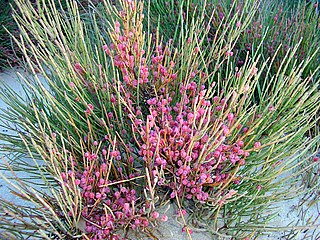
Ephedra fragilis, commonly named the joint pine, is a species of Ephedra that is native to eastern Mediterranean region of southern Europe and Northern Africa, and from Madeira and the Canary Islands in the Atlantic.
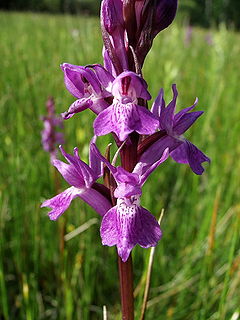
Dactylorhiza elata, the robust marsh orchid, is a species of flowering plant in the family Orchidaceae, native to the western Mediterranean region.

Grevillea alpivaga, also known as buffalo grevillea, is a species of the plant genus Grevillea. It is endemic to Victoria in Australia. The species grows as an erect to prostrate shrub, between 0.3 and 1 metre in height. Flowers usually appear between October and February in its native range. These have pale green, white or cream perianths and styles which are white to pale pink, becoming red.
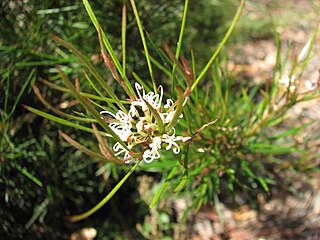
Grevillea neurophylla, commonly known as granite grevillea, is a shrub species in the family Proteaceae. It is native to the states of New South Wales and Victoria in Australia. The species was first formally described by French botanist Michel Gandoger in Bulletin de la Société Botanique de France in 1919. There are two subspecies:

Narcissus romieuxii is a species of flowering plant in the family Amaryllidaceae. It is a distinctive, early-flowering daffodil with dark green rush-like foliage. The flowers have narrow perianth segments, while the trumpet is wide and flaring. It blooms in mid to late winter. There are many subspecies and cultivars, with flowers in many shades of white and yellow. It originated in the Atlas Mountains region of Morocco.

Eugène Pierre Nicolas Fournier was a French botanist. He was particularly interested in ferns. He was a member of the Société Royale de Botanique de Belgique.

Hakea laevipes is a shrub in the family Proteaceae. A widespread species found growing on coastal and tableland locations mainly in eastern New South Wales, with scattered populations in south-eastern Queensland.
The Société botanique de France (SBF) is a French learned society founded on 23 April 1854. At its inaugural meeting it stated its purpose as "to contribute to the progress of botany and related sciences and to facilitate, by all means at its disposal, the education and the work of its members".

Hannonia is a genus of plants in the Amaryllis family. It contains only one known species, Hannonia hesperidum, endemic to Morocco and confined to Western Morocco, Promontory of Hercules. The specific name comes from Greek έσπερος, of evening, as the flowers open in the late afternoon.
Endopappus is a genus of flowering plants in the daisy family described as a genus in 1860.
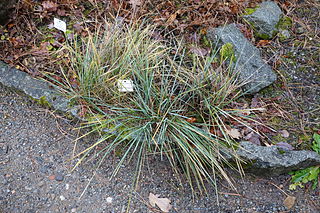
Festuca paniculata is a grass with culms 60–120 cm long, endemic to central, southwestern, and southeastern Europe and northern Africa.
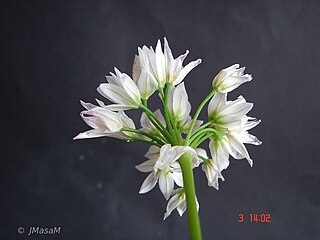
Allium massaessylum is a Western Mediterranean species of wild onion native to Spain, Portugal, Morocco, and Algeria.
Allium litardierei is a North African species of wild onion native to Algeria and Morocco.
(Marie) Louis Emberger was a French botanist and phytogeographer, at the University of Montpellier.
Jean Pierre Adrien Warion was a French medical doctor employed by the French army, and he collected plants between 1861 and 1878.
Étienne Marcellin Granié-Blanc, religious name Frère Sennen (1861–1937), was a French botanist and member (Brother) of the Catholic order Frères des écoles chrétiennes. He collected plants in France, Spain, and Morocco.
Digitalis cedretorum is a species of flowering plant in family Plantaginaceae that is native to Morocco. In the World Flora Online it is listed as a synonym of Digitalis subalpina.












